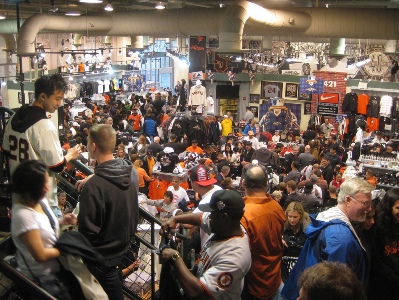Two Reports Examine Trends in Organized Retail Crime
A survey of 129 retailers conducted by the National Retail Federation estimates that organized retail crime (ORC) losses cost retailers about $37 billion last year, up from $34 billion in 2009.
But a Government Accountability Office (GAO) report on ORC, prepared for the House Judiciary Subcommittee on Crime, Terrorism, and Homeland Security, and also released this week, takes issue with the industry's estimate of the size of the problem, saying that "it remains difficult to extrapolate ORC estimates to the retail industry as a whole from a limited sample of respondents."
However, the GAO does not disagree that "ORC is a multi-billion dollar issue that affects retailers and consumers nationwide."
Of retailers surveyed by the NRF, which ranged from restaurants to department stores to specialty retailers and grocery stores, 95 percent said they had been victims of ORC, which they said was becoming more violent. The NRF report also found that ORC was expanding geographically. For the first time, Las Vegas and Phoenix were among the top 10 metropolitan areas named by retailers as being affected by ORC.
The NRF report laments the fact that a bill to establish the Organized Retail Theft Investigation and Prosecution Unit with the Department of Justice failed to pass Congress last year.
GAO interviewed retailers and law enforcement agencies to get a clearer picture of the problem.
Four of eight law enforcement agencies said retail theft and property crimes were often viewed as a lower priority than violent crimes, the GAO report noted. There’s an increasing awareness that ORC is often linked to other criminal activity, but none of the federal agencies GAO interviewed identified ORC as a mission priority. None have specific resources dedicated to conducting these investigations.
The dollar threshold that has to be crossed for ORC cases to be considered felonies varies from state to state; theft of $300 or more is a felony in Illinois; In Wisconsin it’s $2,500. Some states have even raised their felony threshold to free up resources for higher priority cases. ORC perpetrators are generally aware of that and steal below that amount to avoid felony charges, the report notes.
“Linking multiple retail theft events across jurisdictions is often essential to build an ORC case large enough to be considered for felony prosecution,” the GAO report states. No formal federal threshold exists, but stakeholders interviewed for the report said the value of stolen merchandise had to be between $100,000 and $1 million before the FBI will open an investigation.
WHATS BEING DONE:
The report looks at what individual retailers are doing as well as collaborative and government efforts.
The GAO notes that as boosters (the name for ORC thieves) find new ways around existing technology, retailers are challenged to develop new physical deterrents. One retailer uses a display that dispenses on product at a time, for example, adding to the amount of time it would take to steal an entire shelf. Another retailer interviewed for the GAO report was experimenting with recording devices that are activated as a person reaches into a merchandise display. The University of Florida’s Loss Prevention Research Council (LPRC) conducts about 12 research projects a year to identify cost-effective means of deterring crime, notes the report.
Through interviews with retailers, GAO found that criminals prefers stores with minimal interaction with sales associates. All five of the retailers interviewed have loss prevention personnel and teams to investigate theft once it occurs.
The report also notes that eBay introduced a section on their site as a way for retailers to report sellers suspected of trafficking in stolen merchandise. eBay will also work with retailers to draw up reports that show what items are frequently stolen. More than 2,900 law enforcement agencies conducted 12,990 eBay related searches on LeadsOnline, a property databases that utilizes the information provided by ebay, in 2010.
Law enforcement occasionally teams up with retail investigators on cases to conduct surveillance and undercover buyback operationis or to work on flipping lower-level boosters for information on higher level ones. Multijurisdictional cooperation in San Diego in 2008 led to a conviction of the leader of an ORC group and helped close 78 individual theft cases, the report notes.
Immigration and Customs Enforcement (ICE) launched a pilot program in 2009 to combat ORC. After ICE created a code for ORC within its case management system, 83 criminal cases were tied to ORC resulting in 38 arrests, 29 indictments, 14 convictions and the seizure of $4.9 million in cash and property. This year the program was expanded to coordinate with the ICE National Cyber Crimes Center and named SEARCH (Seizing Earnings and Assets from Retail Heists). Forty-eight additional cases involving ORC have been initiated since its launch.
The FBI has moved to launch a similar agency-wide case management program using Crime Problem Indicator (CPI) codes to provide increased detail about crimes and cross reference crime data.
The Los Angeles Police Department, working with the NRF and retailers, funded the development of an information-sharing network called LAAORCA. Other law enforcement agencies in California are using this model and the same contractor to create similar regional networks at very low cost.
One effort that did not get high marks was the Law Enforcement Retail Partnership Network (LERPnet), intended to become a national searchable database of ORC cases. The report notes that promised federal funding never materialized, so the NRF took ownership, and it became operational in 2007. But, GAO says that none of the five retailers it interviewed found LERPnet useful because "it lacked sophisticated analytics to help retailers identify trends" and it lacked standardized data entry. The report notes, however, that in April 2011, LERPnet was acquired by ISO Crime Analytics, and sometime in the summer of 2011, it is expected to relaunch as LERPnet 2.0 with improved analytic capabilities, among other enhancements.
